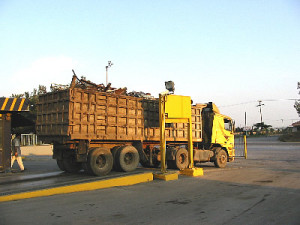It’s all about savings in the multi-billion-dollar recycled radiation business
By Michael Collins
Pasadena Weekly – December 27, 2001
 My neighbor stared intensely at her silverware, eyes bulging. Then she glowered at me. “You mean that this could be radioactive?”
My neighbor stared intensely at her silverware, eyes bulging. Then she glowered at me. “You mean that this could be radioactive?”
Whipping out my Geiger-Counter, this lady’s utensils registered “hot,” meaning that her eating implements had more than a little bit of radioactive “goo” in them. The spoons, forks and knives radiated over four times normal background radiation. Her experience is not unique.
Last year, a local nuclear watchdog group, Committee to Bridge the Gap revealed that radioactive materials were working their way into the consumer product stream. Virtually anything from utensils, pants zippers, teeth braces, belt buckles, hip and the drive shafts of automobiles were being made out of radioactive recycled metal that originated from government contracted facilities.
CBG uncovered the problem when it discovered that 300 tons of radioactive metals had been sold to a San Pedro, California recycler by military industrial giant Rocketdyne. The hot alloy originated at the company’s Santa Susana Field Laboratory located high in the hills between the Simi and San Fernando valleys 35 miles north of Pasadena.
The 2,668-acre facility has long been plagued by radioactive and chemical pollution problems and is currently in the midst of a $258 million cleanup. Indeed, the site experienced a partial meltdown of a nuclear reactor on a hot summer night in 1959 as Americans were watching the televised “Kitchen Debate” in which former Soviet Premier Nikita Khrushchev and then-Vice President Richard Nixon and threatened each other’s nations with nuclear annihilation. According to former Rocketdyne workers, another meltdown occurred in 1964 at an experimental space reactor releasing 80 percent of the reactor’s radioactive core into the atmosphere.
Last year’s CBG discovery of Rocketdyne’s radioactive rock ‘n’ roll isn’t the first time recycled goo has made it into consumer products. In 1983, a truck trundled through a checkpoint at one of America’s premier nuclear research compounds, the Los Alamos National Laboratory in New Mexico. Radioactive sensors picked up that the rig was reading hot and automatically snapped a photograph of the truck’s license plate. After an exhaustive investigation, it was discovered that the truck had been irradiated after carrying recycled radioactive material that had originated from a hospital in Lubbock, Texas. Investigators found that a 46-pound vessel, containing 6,000 metallic pellets of the intensely radioactive element cobalt-60, each 1 millimeter in size, had made its way to a scrap yard in Juarez, Mexico. There it was inadvertently blended with iron scrap and used to make re-bar iron reinforcement bars 2,500 sets of decorative garden table legs for U.S. and Mexican consumers. Two young Mexican men were sterilized by the poisonous material before the metal was confiscated across both countries.
Such recycling of radioactive material sufficiently shocked former Clinton Secretary of Energy Bill Richardson to put a stop to the release of “volumetrically contaminated” radioactive nickel from the Department of Energy (DOE) site in Oak Ridge, Tenn., on Jan. 12, 2000. The decision covered some 6,000 tons of tainted nickel at Oak Ridge and impacted around 10,000 tons of additional volumetrically contaminated metal at DOE sites across the country, including Rocketdyne.
On July 13, 2000, the former energy secretary widened the temporary ban. “I am suspending the unrestricted use of recycled scrap metals from within DOE facilities. This suspension will remain in effect until improvements in our release criteria and information management have been developed,” he wrote in a publicly released memo.
But times change — the Bush administration has new ideas of how to handle hot metal. At an Oct. 9 DOE meeting in Santa Monica, the department DOE outlined its policy that basically posits that the radioactive metal could somehow be safe for Americans to use and be exposed to. The public participation and comment hearing was part of the DOE’s nationwide effort to convince the American people that “goo” is just three quarters of the word “good.”
“Clearly cost issues can’t outweigh health and safety concerns,” DOE facilitator Holmes Brown told the Weekly. “If the health and safety impacts are comparable for all the alternatives, then you go with the lowest costs.” But just what are those costs? DOE admitted that the worth of the approximately million tons of radioactive metal that may be recycled is worth between one to two cents per pound. Quickly crunching the numbers at the meeting, the Weekly estimated that value of the hot alloys is $40 million. Seemingly a trivial amount in light of our nation’s bulging budget, the Weekly called on Brown on where the real money smoking gun lies. “Where the savings are in the disposal of the low-level radioactive waste,” Brown admitted. “That could $3 billion.”
Brown also imparted that the cost of cleaning up the radioactive metallic goo at former and present DOE sites, could top $100 billion, much more than the $60 billion previously thought. This apparently cheapskate and immoral attitude toward the recycling of radioactive metal into the consumer product stream has infuriated environmentalists. “These proposals fly in the face if the fundamental rule of radioactive waste disposal that it should be isolated from the human environment,” said Daniel Hirsch, president of CBG. “They should not (be) purposely inserted into products that come into intimate human contact.”
My neighbor stared at her silverware after watching the Gieger-Counter register radioactivity. “What am I supposed to do with this stuff?” she demanded. “Do I just throw it away or is there someone I can turn it into?” Unfortunately, I didn’t have a ready answer.












Recent Comments